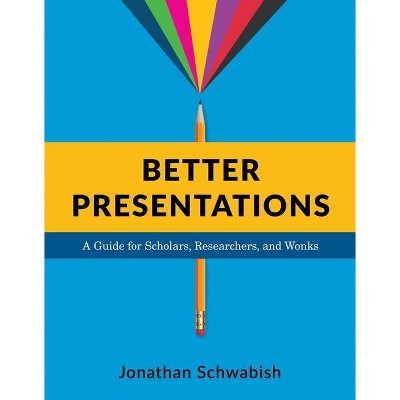Better Presentations - by Jonathan Schwabish (Hardcover)

Similar Products
Products of same category from the store
AllProduct info
<p/><br></br><p><b> About the Book </b></p></br></br>Designed for presenters of scholarly or data-intensive content, <i>Better Presentations</i> details essential strategies for developing clear, sophisticated, and visually captivating presentations. With a range of clear examples for what to do (and what not to do), Jonathan Schwabish shares the best techniques to display work and win over audiences.<p/><br></br><p><b> Book Synopsis </b></p></br></br><p>Whether you are a university professor, researcher at a think tank, graduate student, or analyst at a private firm, chances are that at some point you have presented your work in front of an audience. Most of us approach this task by converting a written document into slides, but the result is often a text-heavy presentation saddled with bullet points, stock images, and graphs too complex for an audience to decipher--much less understand. Presenting is fundamentally different from writing, and with only a little more time, a little more effort, and a little more planning, you can communicate your work with force and clarity.</p><p>Designed for presenters of scholarly or data-intensive content, <em>Better Presentations </em>details essential strategies for developing clear, sophisticated, and visually captivating presentations. Following three core principles--visualize, unify, and focus--<em>Better Presentations</em> describes how to visualize data effectively, find and use images appropriately, choose sensible fonts and colors, edit text for powerful delivery, and restructure a written argument for maximum engagement and persuasion. With a range of clear examples for what to do (and what not to do), the practical package offered in<em> Better Presentations</em> shares the best techniques to display work and the best tactics for winning over audiences. It pushes presenters past the frustration and intimidation of the process to more effective, memorable, and persuasive presentations.</p><p/><br></br><p><b> Review Quotes </b></p></br></br><br>Data visualization has provided a new set of powerful tools to help analysts communicate their ideas more clearly and effectively. Jon Schwabish helped to pioneer the use of these tools in the policy community, and <i>Better Presentations</i> is full of valuable insights that teach his approach to others. Both new and experienced analysts would benefit immensely from reading this book.--Douglas Elmendorf, former director of the Congressional Budget Office<br><br>Do us all a favor: read this book before your next presentation. From font size to data visualization, Schwabish guides you through creating a presentation that will both hold your audience's attention and effectively deliver information.--Susan Dynarski, University of Michigan<br><br>If you are a scientist or scholar who doesn't care about designing beautiful slides for your presentations, you are doing it wrong. Elegance, clarity, and good visual composition make your messages understandable. In this concise book, Jonathan Schwabish outlines simple but essential rules of design and data visualization that anybody can benefit from. Apply them, and I guarantee that you will never again see a bored face in your audience.--Alberto Cairo, University of Miami, author of<i> The Truthful Art: Data, Charts, and Maps for Communication</i><br><br>Many smart people often become selfish idiots when they give a presentation. Jon's much-needed book is a must read for just about anyone asked to share some slides.--Seth Godin, author of <i>Really Bad Powerpoint</i><br><br>Modern scholars spend many hours a week watching or giving presentations; every one of us should be forced to practice the wisdom of Jonathan Schwabish's wonderful short book. I thought I had mastered this craft and imposed my mastery on others, but I learned so much from <i>Better Presentations</i> that from now on, I'll just say "Read the book!"--Robert E. Hall, Stanford University<br><br>Your work can shape the future only when others understand you. You can show how your ideas matter if you master the fundamentals of communication, and this book shows how to do just that.--Carmen Simon, author of <i>Impossible to Ignore</i><br><p/><br></br><p><b> About the Author </b></p></br></br>Jonathan Schwabish is a senior research associate at the Urban Institute's Income and Benefits Policy Center. He is also a member of the Institute's communication team, specializing in data visualization and presentation design. He has published widely in economics journals, including the <i>National Tax Journal</i>, the<i> Journal of Human Resources</i>, and the <i>Journal of Economic Perspectives</i>. He is the coauthor, with Robert Haveman and Andrew Bershadker, of <i>Human Capital in the United States from 1975 to 2000: Patterns of Growth and Utilization</i> (2006). He can be found on Twitter at @jschwabish.
Price History
Price Archive shows prices from various stores, lets you see history and find the cheapest. There is no actual sale on the website. For all support, inquiry and suggestion messagescommunication@pricearchive.us




















